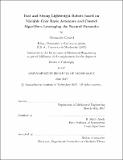| dc.contributor.advisor | H. Harry Asada. | en_US |
| dc.contributor.author | Girard, Alexandre, 1987- | en_US |
| dc.contributor.other | Massachusetts Institute of Technology. Department of Mechanical Engineering. | en_US |
| dc.date.accessioned | 2017-10-04T14:47:02Z | |
| dc.date.available | 2017-10-04T14:47:02Z | |
| dc.date.copyright | 2017 | en_US |
| dc.date.issued | 2017 | en_US |
| dc.identifier.uri | http://hdl.handle.net/1721.1/111689 | |
| dc.description | Thesis: Ph. D., Massachusetts Institute of Technology, Department of Mechanical Engineering, 2017. | en_US |
| dc.description | This electronic version was submitted by the student author. The certified thesis is available in the Institute Archives and Special Collections. | en_US |
| dc.description | Cataloged from student-submitted PDF version of thesis. | en_US |
| dc.description | Includes bibliographical references (pages 191-196). | en_US |
| dc.description.abstract | In many applications, robots have to bear large loads while moving slowly and also have to move quickly through the air with almost no load. These type of bi-modal tasks, with conflicting requirements in terms of operating speeds and desired impedances, often lead to the use of oversized and inefficient actuators which are inhibitory particularly for mobile robots. Multiple gear ratios, like in a powertrain, address this issue by allowing an effective use of power over a wide range of output speeds, by enabling significant changes to the reflected intrinsic actuator impedances and by making possible the leveraging or attenuation of the natural load dynamics. This thesis aims to develop the technological solutions needed to use variable gear ratio actuators and exploit the advantages of variable transmissions in a robotic context. First, by addressing the issue of how to make fast and seamless gearshifts between two very different reduction ratios under diverse load conditions, with a solution based on a dual-motor actuator architecture and a control scheme using the null space. Second, by developing control algorithms that select optimal gear ratios dynamically based on state feedback, to move with minimal motor torques and to adjust the output impedance appropriately given a task. The proposed approach exploit variable transmissions not merely for increasing maximum torque and speed, but also to significantly alter the dynamic properties, including load sensitivity, robustness, and backdrivability. Simulations and experiments using a novel lightweight robotic arm using three custom-built dual-speed dual-motor actuators are presented. Results demonstrate very fast gear shifting in highly dynamic situations with dual-speed dual-motor actuators, and show that actively changing gear ratios using the proposed control algorithms can lead to an order-of-magnitude reduction of necessary motor torque and power. | en_US |
| dc.description.statementofresponsibility | by Alexandre Girard. | en_US |
| dc.format.extent | 196 pages | en_US |
| dc.language.iso | eng | en_US |
| dc.publisher | Massachusetts Institute of Technology | en_US |
| dc.rights | MIT theses are protected by copyright. They may be viewed, downloaded, or printed from this source but further reproduction or distribution in any format is prohibited without written permission. | en_US |
| dc.rights.uri | http://dspace.mit.edu/handle/1721.1/7582 | en_US |
| dc.subject | Mechanical Engineering. | en_US |
| dc.title | Fast and strong lightweight robots based on variable gear ratio actuators and control algorithms leveraging the natural dynamics | en_US |
| dc.type | Thesis | en_US |
| dc.description.degree | Ph. D. | en_US |
| dc.contributor.department | Massachusetts Institute of Technology. Department of Mechanical Engineering | |
| dc.identifier.oclc | 1004236158 | en_US |
